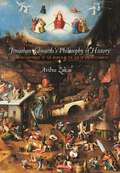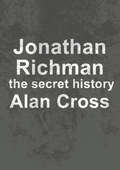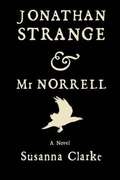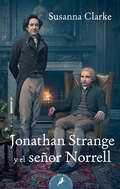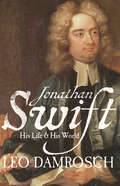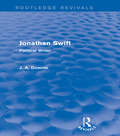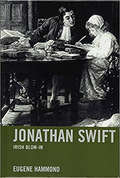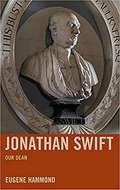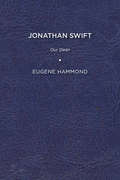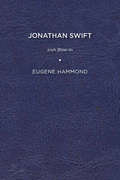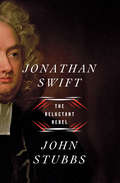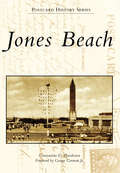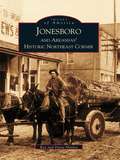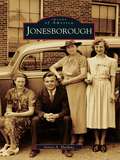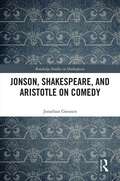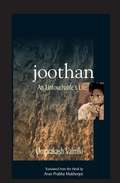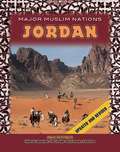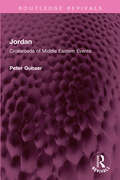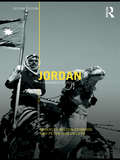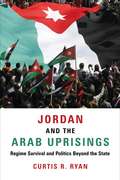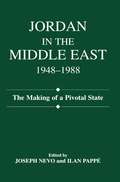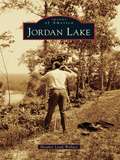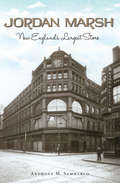- Table View
- List View
Jonathan Edwards's Philosophy of History: The Reenchantment of the World in the Age of Enlightenment
by Avihu ZakaiAvihu Zakai analyzes Jonathan Edwards's redemptive mode of historical thought in the context of the Enlightenment. As theologian and philosopher, Edwards has long been a towering figure in American intellectual history. Nevertheless, and despite Edwards's intense engagement with the nature of time and the meaning of history, there has been no serious attempt to explore his philosophy of history. Offering the first such exploration, Zakai considers Edwards's historical thought as a reaction, in part, to the varieties of Enlightenment historical narratives and their growing disregard for theistic considerations. Zakai analyzes the ideological origins of Edwards's insistence that the process of history depends solely on God's redemptive activity in time as manifested in a series of revivals throughout history, reading this doctrine as an answer to the threat posed to the Christian theological teleology of history by the early modern emergence of a secular conception of history and the modern legitimation of historical time. In response to the Enlightenment refashioning of secular, historical time and its growing emphasis on human agency, Edwards strove to re-establish God's preeminence within the order of time. Against the de-Christianization of history and removal of divine power from the historical process, he sought to re-enthrone God as the author and lord of history--and thus to re-enchant the historical world. Placing Edwards's historical thought in its broadest context, this book will be welcomed by those who study early modern history, American history, or religious culture and experience in America.
Jonathan Richman: the secret history
by Alan CrossAlan Cross is the preeminent chronicler of popular music.Here he provides a history of alt-rock cult figure Jonathan Richman."Boston's Anti-hippie Punk Pioneer" is adapted from the audiobook of the same name.
Jonathan Strange and Mr. Norrell
by Susanna ClarkeEnglish magicians were once the wonder of the known world, with fairy servants at their beck and call; they could command winds, mountains, and woods. But by the early 1800s they have long since lost the ability to perform magic. They can only write long, dull papers about it, while fairy servants are nothing but a fading memory.<P><P> But at Hurtfew Abbey in Yorkshire, the rich, reclusive Mr Norrell has assembled a wonderful library of lost and forgotten books from England's magical past and regained some of the powers of England's magicians. He goes to London and raises a beautiful young woman from the dead. Soon he is lending his help to the government in the war against Napoleon Bonaparte, creating ghostly fleets of rain-ships to confuse and alarm the French.<P> All goes well until a rival magician appears. Jonathan Strange is handsome, charming, and talkative - the very opposite of Mr Norrell. Strange thinks nothing of enduring the rigors of campaigning with Wellington's army and doing magic on battlefields. Astonished to find another practicing magician, Mr Norrell accepts Strange as a pupil. But it soon becomes clear that their ideas of what English magic ought to be are very different. For Mr Norrell, their power is something to be cautiously controlled, while Jonathan Strange will always be attracted to the wildest, most perilous forms of magic. He becomes fascinated by the ancient, shadowy figure of the Raven King, a child taken by fairies who became king of both England and Faerie, and the most legendary magician of all. Eventually Strange's heedless pursuit of long-forgotten magic threatens to destroy not only his partnership with Norrell, but everything that he holds dear.<P> Sophisticated, witty, and ingeniously convincing, Susanna Clarke's magisterial novel weaves magic into a flawlessly detailed vision of historical England. She has created a world so thoroughly enchanting that eight hundred pages leave readers longing for more.<P> Hugo Award winner.
Jonathan Strange y el señor Norrell
by Susanna ClarkeUna de las novelas más brillantes y originales que han aparecido en el panorama anglosajón en los últimos tiempos. Una mezcla prodigiosa de fantasía e historia, en la que los magos conviven con personajes reales y que plantea una historia alternativa de Inglaterra. A principios del siglo XIX, las hazañas del Rey Cuervo, el más grande de todos los magos de la Edad Media, perviven en la memoria y la leyenda, pero la práctica de la magia ha sido completamente olvidada en Inglaterra. Hasta el día en que el esquivo señor Norrell, de Hurtfew Abbey, logra que las piedras de la catedral de York hablen. La noticia del retorno de la magia se extiende como la pólvora y el señor Norrell, convencido de que debe poner sus artes al servicio del gobierno en la guerra contra Napoleón, se traslada a Londres. Allí conoce al joven Jonathan Strange, un brillante y voluntarioso mago, y tras superar algunos recelos, consiente en acogerlo como discípulo. En una época en la que sólo los charlatanes se hacían llamar magos, Norrell y Strange se proponen limpiar el buen nombre de su oficio, al que consideran una ciencia con mayúsculas. Bajo las órdenes de Wellington, realizarán decenas de actos mágicos, y su éxito es tal que muy pronto se los consultará sobre muchos otros problemas, desde la curación de la locura del rey Jorge III hasta la mejor venganza para amantes despechados. A su paso encontrarán amor y muerte, portentos y crueldades, y arrastrados por la ambición y la rivalidad, el camino de la gloria los acercará irremediablemente al abismo. Entre la fina comedia social de Jane Austen y el sombrío universo de Tolkien, Susanna Clarke ha logrado crear un mundo imaginario de enorme belleza y misterio. Distinguida como Mejor Novela del Año por los libreros independientes de Estados Unidos y candidata a los premios Whitbread, Booker y Guardian, Jonathan Strange y el señor Norrell ha sido generosamente elogiada por la crítica y ha permanecido en las listas de los libros más vendidos de Estados Unidos, Gran Bretaña y Alemania desde su publicación. La crítica ha dicho...«Jonathan Strange y el señor Norrell es, sin duda, la mejor novela fantástica inglesa escrita en los últimos setenta años.»Neil Gaiman «Un clásico desde su aparición.»Kirkus Reviews «Una obra prodigiosa.»Sunday Times «Un placer inmenso.»Times Literary Supplement
Jonathan Swift: His Life and His World
by Leo DamroschJonathan Swift is best remembered today as the author of Gulliver's Travels, the satiric fantasy that quickly became a classic and has remained in print for nearly three centuries. Yet Swift also wrote many other influential works, was a major political and religious figure in his time, and became a national hero, beloved for his fierce protest against English exploitation of his native Ireland. What is really known today about the enigmatic man behind these accomplishments? Can the facts of his life be separated from the fictions? In this deeply researched biography, Leo Damrosch draws on discoveries made over the past thirty years to tell the story of Swift's life anew. Probing holes in the existing evidence, he takes seriously some daring speculations about Swift's parentage, love life, and various personal relationships and shows how Swift's public version of his life--the one accepted until recently--was deliberately misleading. Swift concealed aspects of himself and his relationships, and other people in his life helped to keep his secrets. . Assembling suggestive clues, Damrosch re-narrates the events of Swift's life while making vivid the scents, sounds, and smells of his English and Irish surroundings. Through his own words and those of a wide circle of friends, a complex Swift emerges: a restless, combative, empathetic figure, a man of biting wit and powerful mind, and a major figure in the history of world letters.
Jonathan Swift: Political Writer (Routledge Revivals)
by Alan DownieFirst published in 1984, this biography gives an account of Jonathan Swift’s political ideas and provides a critical commentary on his major works. With its emphasis on Swift as a political writer, the title offers a revision of the prevailing view of Swift’s politics and its application in the study of his works. Alan Downie argues that in terms of the party politics of the day Swift is neither a Whig nor Tory. Swift thought of himself as an ‘Old Whig’, and said he was ‘of the old Whig principles, without the modern articles and refinements’. Downie shows how Swift’s writings consistently make political points about society’s deviation from an ideal. As Swift’s views on morality, religion and politics are so closely linked, an understanding of his political ideas is vital; this reissue provides a detailed analysis of this aspect of Swift’s writings and views, and as such will be of great interest to any students researching his satire.
Jonathan Swift: Irish Blow-In
by Eugene HammondJonathan Swift: Irish Blow-in covers the arc of the first half of Jonathan Swift’s life, offering fresh details of the contentment and exuberance of his childhood, of the support he received from his grandmother, of his striking affection for Esther Johnson from the time she was ten years old (his pet name for her in her twenties was “saucebox”), of his precocious entry into English politics with his Contests and Dissensions pamphlet, of his brilliant and much misunderstood Tale of a Tub, and of his naive determination to do well both as a vicar of the small parish of Laracor in Ireland and as a writer for the Tory administration trying to pull England out of debt by ending the war England was engaged in with France. I do not share with past biographers the sense that Swift had a deprived childhood. I do not share the suspicion that most of Swift’s enmities were politically motivated. I do not feel critical of him because he was often fastidious with his money. I do not think he was insincere about his religious faith. His pride, his sexual interests, his often shocking or uninhibited language, his instinct for revenge – emphasized by many previous biographers – were all fundamental elements of his being, but elements that he either used for rhetorical effect, or that he tried to keep in check, and that he felt that religion helped him to keep in check. Swift had as firm a conviction as did Freud that we are born with wayward tendencies; unlike Freud, though, he saw both religion and civil society as necessary and helpful checks on those wayward tendencies, and he (frequently, but certainly not always) acknowledged that he shared those tendencies with the rest of us. This biography, in two books, Jonathan Swift: Irish Blow-in and Jonathan Swift:Our Dean, will differ from most literary biographies in that it does not aim to show how Swift’s life illuminates his writings, but rather how and why Swift wrote in order to live the life he wanted to live. I have liberally quoted Swift’s own words in this biography because his inventive expression of ideas, both in his public works and in his private letters, was what has made him a unique and compelling figure in the history of literature. I hope in these two books to come closer than past biographies to capturing how it felt to Swift himself to live his life. Published by University of Delaware Press. Distributed worldwide by Rutgers University Press.
Jonathan Swift: Our Dean
by Eugene HammondJonathan Swift: Our Dean details the political climax of his remarkable career—his writing and publication of The Drapier’s Letters (1724), Gulliver’s Travels (1726), and A Modest Proposal (1729)—stressing the relentless political opposition he faced and the numerous ways, including through his sermons, that he worked from his political base as Dean of St. Patrick’s Cathedral, psychologically as well as physically just outside the Dublin city walls, to attempt to rouse the Irish people to awareness of the ways that England was abusing them. This book faces squarely the likelihood that Swift had a physical affair with Esther Vanhomrigh between 1719 and 1723, and reassesses in the light of that likelihood his conflicting relations with Esther Vanhomrigh and Esther Johnson. It traces the many loving friendships with both men and women in Ireland that sustained Swift during the years when his health gradually failed him, enabling him to continue indefatiguably, both through his writings and his authority as Dean of St. Patrick’s, to contribute to the public welfare in the face of relentless British attempts to squeeze greater and greater profits out of their Irish colony. Finally, it traces how Swift’s political indignation led to his treating many people, friends and enemies, cruelly during the 1730s, even while his humor and his ability to make and attract new friends sustained themselves until his memory finally failed him in 1742. This biography, in two books, Jonathan Swift: Irish Blow-in and Jonathan Swift:Our Dean, comes closer than past biographies to capturing how it felt to Swift himself to live his life. Published by University of Delaware Press. Distributed worldwide by Rutgers University Press.
Jonathan Swift: Our Dean
by Eugene HammondJonathan Swift: Our Dean details the political climax of his remarkable career—his writing and publication of The Drapier’s Letters (1724), Gulliver’s Travels (1726), and A Modest Proposal (1729)—stressing the relentless political opposition he faced and the numerous ways, including through his sermons, that he worked from his political base as Dean of St. Patrick’s Cathedral, psychologically as well as physically just outside the Dublin city walls, to attempt to rouse the Irish people to awareness of the ways that England was abusing them. This book faces squarely the likelihood that Swift had a physical affair with Esther Vanhomrigh between 1719 and 1723, and reassesses in the light of that likelihood his conflicting relations with Esther Vanhomrigh and Esther Johnson. It traces the many loving friendships with both men and women in Ireland that sustained Swift during the years when his health gradually failed him, enabling him to continue indefatiguably, both through his writings and his authority as Dean of St. Patrick’s, to contribute to the public welfare in the face of relentless British attempts to squeeze greater and greater profits out of their Irish colony. Finally, it traces how Swift’s political indignation led to his treating many people, friends and enemies, cruelly during the 1730s, even while his humor and his ability to make and attract new friends sustained themselves until his memory finally failed him in 1742. This biography, in two books, Jonathan Swift: Irish Blow-in and Jonathan Swift:Our Dean, comes closer than past biographies to capturing how it felt to Swift himself to live his life. Published by University of Delaware Press. Distributed worldwide by Rutgers University Press.
Jonathan Swift: Irish Blow-In
by Eugene HammondJonathan Swift: Irish Blow-in covers the arc of the first half of Jonathan Swift’s life, offering fresh details of the contentment and exuberance of his childhood, of the support he received from his grandmother, of his striking affection for Esther Johnson from the time she was ten years old (his pet name for her in her twenties was “saucebox”), of his precocious entry into English politics with his Contests and Dissensions pamphlet, of his brilliant and much misunderstood Tale of a Tub, and of his naive determination to do well both as a vicar of the small parish of Laracor in Ireland and as a writer for the Tory administration trying to pull England out of debt by ending the war England was engaged in with France. I do not share with past biographers the sense that Swift had a deprived childhood. I do not share the suspicion that most of Swift’s enmities were politically motivated. I do not feel critical of him because he was often fastidious with his money. I do not think he was insincere about his religious faith. His pride, his sexual interests, his often shocking or uninhibited language, his instinct for revenge – emphasized by many previous biographers – were all fundamental elements of his being, but elements that he either used for rhetorical effect, or that he tried to keep in check, and that he felt that religion helped him to keep in check. Swift had as firm a conviction as did Freud that we are born with wayward tendencies; unlike Freud, though, he saw both religion and civil society as necessary and helpful checks on those wayward tendencies, and he (frequently, but certainly not always) acknowledged that he shared those tendencies with the rest of us. This biography, in two books, Jonathan Swift: Irish Blow-in and Jonathan Swift: Our Dean, will differ from most literary biographies in that it does not aim to show how Swift’s life illuminates his writings, but rather how and why Swift wrote in order to live the life he wanted to live. I have liberally quoted Swift’s own words in this biography because his inventive expression of ideas, both in his public works and in his private letters, was what has made him a unique and compelling figure in the history of literature. I hope in these two books to come closer than past biographies to capturing how it felt to Swift himself to live his life. Published by University of Delaware Press. Distributed worldwide by Rutgers University Press.
Jonathan Swift: The Reluctant Rebel
by John StubbsA rich and riveting portrait of the man behind Gulliver’s Travels, by a “vivid, ardent, and engaging” (New York Times Book Review) author. One of Europe’s most important literary figures, Jonathan Swift was also an inspired humorist, a beloved companion, and a conscientious Anglican minister—as well as a hoaxer and a teller of tales. His anger against abuses of power would produce the most famous satires of the English language: Gulliver’s Travels as well as the Drapier Papers and the unparalleled Modest Proposal, in which he imagined the poor of Ireland farming their infants for the tables of wealthy colonists. John Stubbs’s biography captures the dirt and beauty of a world that Swift both scorned and sought to amend. It follows Swift through his many battles, for and against authority, and in his many contradictions, as a priest who sought to uphold the dogma of his church; as a man who was quite prepared to defy convention, not least in his unshakable attachment to an unmarried woman, his “Stella”; and as a writer whose vision showed that no single creed holds all the answers. Impeccably researched and beautifully told, in Jonathan Swift Stubbs has found the perfect subject for this masterfully told biography of a reluctant rebel—a voice of withering disenchantment unrivaled in English.
Jonathan Swift and the Eighteenth-Century Book
by Paddy Bullard James MclavertyJonathan Swift lived through a period of turbulence and innovation in the evolution of the book. His publications, perhaps more than those of any other single author, illustrate the range of developments that transformed print culture during the early Enlightenment. Swift was a prolific author and a frequent visitor at the printing house, and he wrote as critic and satirist about the nature of text. The shifting moods of irony, complicity and indignation that characterise his dealings with the book trade add a layer of complexity to the bibliographic record of his published works. The essays collected here offer the first comprehensive, integrated survey of that record. They shed new light on the politics of the eighteenth-century book trade, on Swift's innovations as a maker of books, on the habits and opinions revealed by his commentary on printed texts and on the re-shaping of the Swiftian book after his death.
Jones Beach (Postcard History Series)
by Constantine E. Theodosiou George Gorman Jr.Envisioning a noble beachfront park so ordinary people could enjoy a slice of the good life, master builder Robert Moses set out to transform a little-known barrier island off Long Island's South Shore into the civic masterpiece now known as Jones Beach State Park. All vacationers and day-trippers had to do was simply follow its beloved mascot, the Jones Beach seahorse, for an unforgettable day of sand and surf, or for a swim in the saltwater pool at the West Bathhouse, a stroll along the boardwalk, or a friendly match of shuffleboard, pitch-putt golf, or archery. The Indian Village also awaited, as well as fine dining at the Boardwalk Restaurant, a musical at the Marine Theatre, or a night of dancing to the songs of Guy Lombardo.
Jonesboro and Arkansas's Historic Northeast Corner (Images of America)
by Ray Hanley Diane HanleyWhen Union soldiers returned North after the Civil War, they brought home stories of a sparsely populated area with bountiful timber and potential for homes and farms. Over the next 50 years, first by wagon train and then by railroads, settlers came to build not only homes and farms but also thriving communities in the Clay, Greene, and Craighead counties of northeastern Arkansas. Today, visitors and residents of the area see the bustle of Jonesboro and the thriving Arkansas State University. Readers of Jonesboro and Arkansas' Historic Northeast Corner will discover Jonesboro as it lived a century ago, a promising town of 7,000 citizens. As the 20th Century opened, modern and attractive towns such as Corning, Piggott, Rector, and Paragould began to thrive. The evolution of these historic areas-from slow-paced villages with dirt roads and horse-drawn wagons to the bustling towns of the late 20th century-is chronicled in this Images of America edition.
Jonesborough (Images of America)
by Sonya A. HaskinsOriginally established in 1779 as the seat of Washington County, North Carolina, Jonesborough is the oldest incorporated town in Tennessee. Early pioneers were given land grants to settle west of the mountains, but by 1784, they no longer trusted their political leaders in North Carolina. They created their own local government and established the state of Franklin, naming Jonesborough the original capital of the "lost" 14th state. Never recognized by Congress, Franklin eventually fizzled out and Tennessee was formed. Although Tennessee was a slave-holding state prior to the Civil War, Jonesborough produced the earliest regularly published periodical devoted to abolishing slavery. Today, Jonesborough is listed on the National Register of Historic Places, with many buildings fully restored. In this volume, readers will see the Christopher Taylor House, which was built about 1778, and the Chester Inn, which hosted many famous guests in its original days, including Presidents Andrew Jackson, Andrew Johnson, and James K. Polk.
Jonson, Shakespeare, and Aristotle on Comedy (Routledge Studies in Shakespeare)
by Jonathan GoossenJonson, Shakespeare, and Aristotle on Comedy relates new understandings of Aristotle’s dramatic theory to the comedy of Ben Jonson and William Shakespeare. Typically, scholars of Renaissance drama have treated Aristotle’s theory only as a possible historical influence on Jonson’s and Shakespeare’s drama, focusing primarily on their tragedies. Yet recent classical scholarship has undone important misconceptions about Aristotle’s Poetics held by early modern commentators and fleshed out the theory of comedy latent within it. By first synthesizing these developments and then treating them as an interpretive theory, rather than simply an historical influence, this book demonstrates a remarkable consonance between Aristotelian principles of plot and its emotional effect, on the one hand, and the comedy of Shakespeare and Jonson, on the other. In doing so, it also reveals surprising similarities between these seemingly divergent dramatists.
Jony Ive: The Genius Behind Apple's Greatest Products
by Leander KahneyIn 1997, Steve Jobs returned to Apple as CEO with the unenviable task of turning around the company he had founded. One night, Jobs discovered a scruffy British designer toiling away at Apple¿s corporate headquarters, surrounded by hundreds of sketches and prototypes. It was then that Jobs realized he had found a talent who could reverse the company¿s long decline. That young designer was Jony Ive. Jony Ive¿s collaboration with Jobs would produce some of the world¿s most iconic technology products, including the iMac, iPod, iPad, and iPhone. The designs have not only made Apple a hugely valuable company, they¿ve overturned entire industries, built a loyal fan base, and created a globally powerful brand. Along the way, Jony Ive has become the world¿s leading technology innovator, won countless design awards, earned a place on the 2013 Time 100 list, and was even knighted for his services to design and enterprise. Yet despite his triumphs, little is known about the shy and soft-spoken whiz whom Jobs referred to as his "spiritual partner" at Apple. Jony Ive reveals the true story of Apple¿s real innovator-in-chief. Leander Kahney, the bestselling author of Inside Steve¿s Brain, offers a detailed portrait of a creative genius. He shows us how Jony Ive went from an English art school student with dyslexia to the man whose immense insights have altered the pattern of our lives. From his early interest in industrial design, fostered by his designer father, through his education at Newcastle Polytechnic and meteoric rise at Apple, we discover the principles and practices that he developed to become the designer of his generation. Based on interviews with Jony Ive¿s former colleagues and Kahney¿s own familiarity with the world of Apple, this book gives insight into how Jony Ive (now senior vice president of design) has redefined the ways in which we work, entertain, and communicate with one another.
Joothan: An Untouchable's Life
by Omprakash Valmiki Arun Prabha MukherjeeOmprakash Valmiki describes his life as an untouchable, or Dalit, in the newly independent India of the 1950s. "Joothan" refers to scraps of food left on a plate, destined for the garbage or animals. India's untouchables have been forced to accept and eat joothan for centuries, and the word encapsulates the pain, humiliation, and poverty of a community forced to live at the bottom of India's social pyramid. Although untouchability was abolished in 1949, Dalits continued to face discrimination, economic deprivation, violence, and ridicule. Valmiki shares his heroic struggle to survive a preordained life of perpetual physical and mental persecution and his transformation into a speaking subject under the influence of the great Dalit political leader, B. R. Ambedkar. A document of the long-silenced and long-denied sufferings of the Dalits, Joothan is a major contribution to the archives of Dalit history and a manifesto for the revolutionary transformation of society and human consciousness.
Jordan
by Anna Carew-MillerThough small and resource poor, the Hashemite Kingdom of Jordan plays a crucial role in the affairs of the volatile Middle East. A moderate Arab country, Jordan borders not only Israel and the West Bank, but also Syria, Iraq, and Saudi Arabia. This strategic location- along with the nuanced and forward-looking foreign policy crafted by its longtime monarch, King Hussein, and carried on by his son and successor, King Abdullah II?has made Jordan a key to peace and stability in the Middle East.Domestically, Jordan faces many of the same economic hurdles developing nations all over the world must confront. But it also enjoys a tremendous advantage: a highly educated, adaptable workforce.
Jordan: Crossroads of Middle Eastern Events (Routledge Revivals)
by Peter GubserFirst published in 1983 Jordan: Crossroads of Middle Eastern Events examines Jordan’s unique role in the Middle East- Arab- Israeli conflict focusing also on its attempt and partial success, at developing its economy and society in the face of a dearth of natural resources and a large influx of refugees. Woven throughout the narrative is the role of King Hussain, a singular Arab ruler, master player on both the Middle Eastern and world stages even though his country lacks significant assets or power in either those arenas. Peter Gubser describes Jordan’s people, culture, history, and social structure, then looks at how the country, buffeted in the tumultuous Middle East, hampered by limited internal political development, and strained by its rapid transition from a peasant, Bedouin economy to one dominated by refugee problems, has moved forward to a much sounder economy based on diversification- in agriculture, industry, mineral extraction, and services. The author argues that Jordan once almost entirely depended on the West for economic largess as well as for political support, now has major Arab sources of assistance and is reorienting its foreign policy accordingly. This is a must read for scholars and researchers of Middle East studies, Middle East history and Middle East politics.
Jordan: A Hashemite Legacy (The Contemporary Middle East #Vol. 7)
by Beverley Milton-Edwards Peter HinchcliffeCreated as a mechanism for maintaining British influence through a local patron, Jordan’s future never looked certain. Nevertheless, under the leadership of the Hashemite monarchy led by Abdullah and then his grandson Hussein, the Kingdom of Jordan became a permanent feature on the map of the modern Middle East. Under the rule of King Abdullah II, Jordan has remained an influential regional player in the Middle East Peace Process, its strategic position on the borders of Palestine, Israel, Egypt, Saudi Arabia and Iraq ensuring that it cannot be overlooked in the regional and international politics. Updated and expanded to include recent developments in Jordan and the Middle East, the new edition includes coverage and discussion of: the reign of King Abdullah II the involvement of the US in the Iraq war and the effect on this on Jordan’s alignment with the West the country’s recent economic growth, with an emphasis on economic liberalisation, privatisation, promotion of tourism and encouragement of foreign investment the position of Jordan as a point of continuity in an increasingly unstable Middle East. This volume, intended for both academic and general readers, offers an overview of the history, politics and economics of this fascinating country and its role in a region disfigured by the Arab-Israeli conflict.
Jordan and the Arab Uprisings: Regime Survival and Politics Beyond the State (Columbia Studies in Middle East Politics)
by Curtis R. RyanIn 2011, as the Arab uprisings spread across the Middle East, Jordan remained more stable than any of its neighbors. Despite strife at its borders and an influx of refugees connected to the Syrian civil war and the rise of ISIS, as well as its own version of the Arab Spring with protests and popular mobilization demanding change, Jordan managed to avoid political upheaval. How did the regime survive in the face of the pressures unleashed by the Arab uprisings? What does its resilience tell us about the prospects for reform or revolutionary change?In Jordan and the Arab Uprisings, Curtis R. Ryan explains how Jordan weathered the turmoil of the Arab Spring. Crossing divides between state and society, government and opposition, Ryan analyzes key features of Jordanian politics, including Islamist and leftist opposition parties, youth movements, and other forms of activism, as well as struggles over elections, reform, and identity. He details regime survival strategies, laying out how the monarchy has held out the possibility of reform while also seeking to coopt and contain its opponents. Ryan demonstrates how domestic politics were affected by both regional unrest and international support for the regime, and how regime survival and security concerns trumped hopes for greater change. While the Arab Spring may be over, Ryan shows that political activism in Jordan is not, and that struggles for reform and change will continue. Drawing on extensive fieldwork and interviews with a vast range of people, from grassroots activists to King Abdullah II, Jordan and the Arab Uprisings is a definitive analysis of Jordanian politics before, during, and beyond the Arab uprisings.
Jordan in the Middle East, 1948-1988: The Making of Pivotal State
by Ilan Pappé Joseph NevoA collection of articles assessing Jordan's position in the region in light of its quest for legitimacy as a state and as a Hashemite monarchy. Describes the country's role in the conflict with Israel and the balance of power between Palestinians and East Bankers.
Jordan Lake
by Heather Leigh WallaceIn 1945, Hurricane 9 rocked the Carolinas, severely flooding and incapacitating the New Hope Valley area. As a result, Congress directed the U.S. Army Corps of Engineers to study water resource needs in the area. Originally named the New Hope Project, it received funding in 1963, and construction began in 1967. In 1974, after lake supporter Sen. B. Everett Jordan passed away, the lake and dam were renamed in his honor. The senator never saw the lake finished, as it was not filled until 1982. Jordan Lake encompasses 46,768 acres of which 13,900 acres are flooded to form a reservoir at 216 feet above mean sea level. The lake provides recreation, wildlife conservation, and water supply to surrounding cities. Jordan Lake also attracts one of the largest concentrations of bald eagles in the southeast. With photographs from the flood of 1945 to a group baptism in 2007, these stories and more will make you want to spend an afternoon at Jordan Lake.
Jordan Marsh: New England’s Largest Store (Landmarks)
by Anthony M. SammarcoJordan Marsh opened its first store in 1851 on Milk Street in Boston selling assorted dry goods. Following the Civil War, the store moved to Winthrop Square and later to Washington Street between Summer and Avon Streets. The new five-story building, designed by Winslow & Wetherell, unveiled the novel concept of department shopping under one roof. It attracted shoppers by offering personal service with the adage that the customer is always right, easy credit, art exhibitions and musical performances. By the 1970s, it had become a regional New England icon and the largest department store chain in the nation. Author and historian Anthony Sammarco reveals the fascinating history of Boston’s beloved Jordan Marsh.
